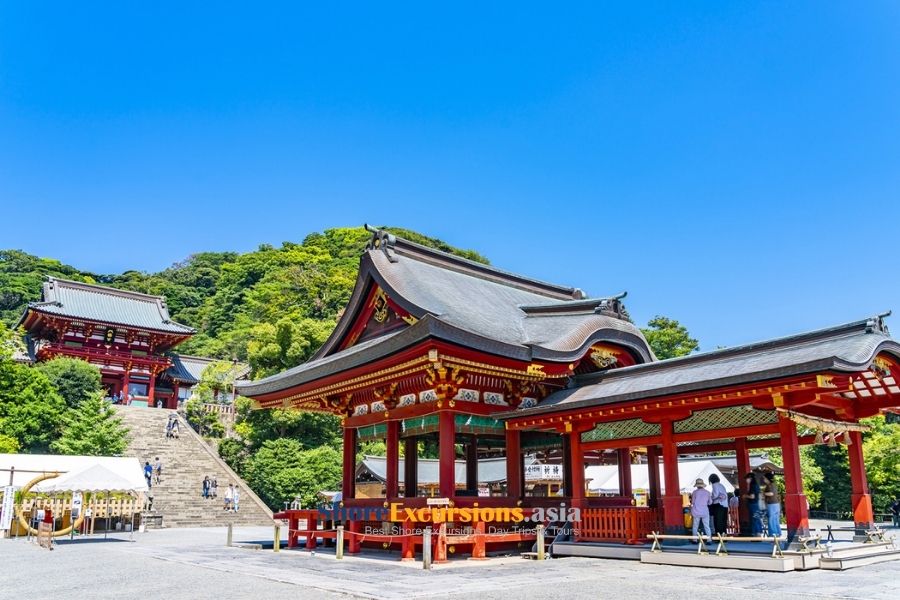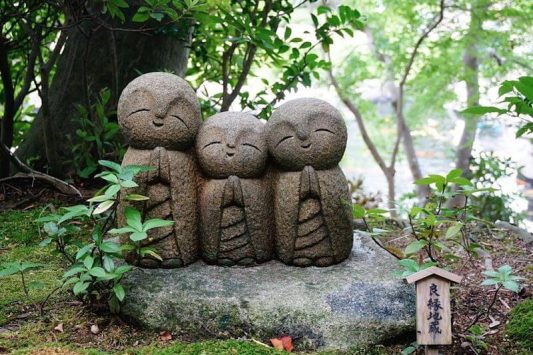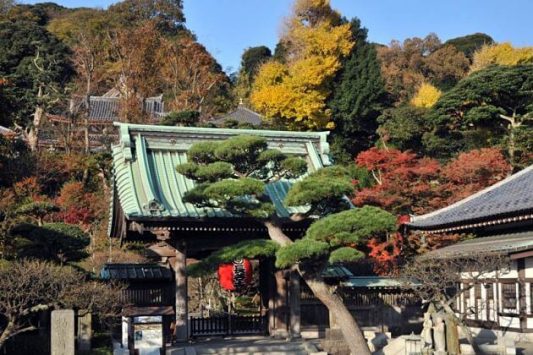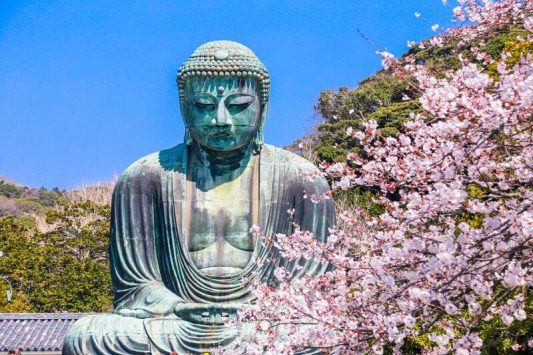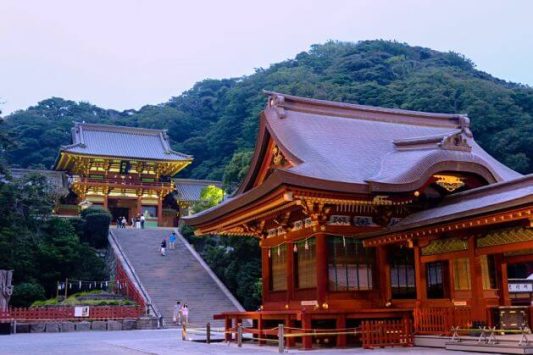Kamakura, once the political heart of Japan and home to the shogunate, remains one of the most historically significant cities in the country. Among its many temples and shrines, Tsurugaoka Hachimangu Shrine stands as the most prominent. This Shinto shrine is more than just an architectural landmark, it represents the rise of the samurai class, the spiritual devotion of centuries, and the enduring traditions of Japanese culture. For visitors on a Tokyo day tours from cruise port, it offers an accessible and deeply rewarding window into the nation’s history and spirituality.
The Origins of Tsurugaoka Hachimangu
The story of Tsurugaoka Hachimangu is tightly woven with the destiny of the Minamoto clan, one of Japan’s most influential warrior families. Founded originally in 1063 by Minamoto no Yoriyoshi, the shrine was relocated and expanded in 1180 by his descendant Minamoto no Yoritomo, the founder of the Kamakura shogunate. It became a powerful symbol of the samurai ethos and a site where spiritual guidance intertwined with military power.
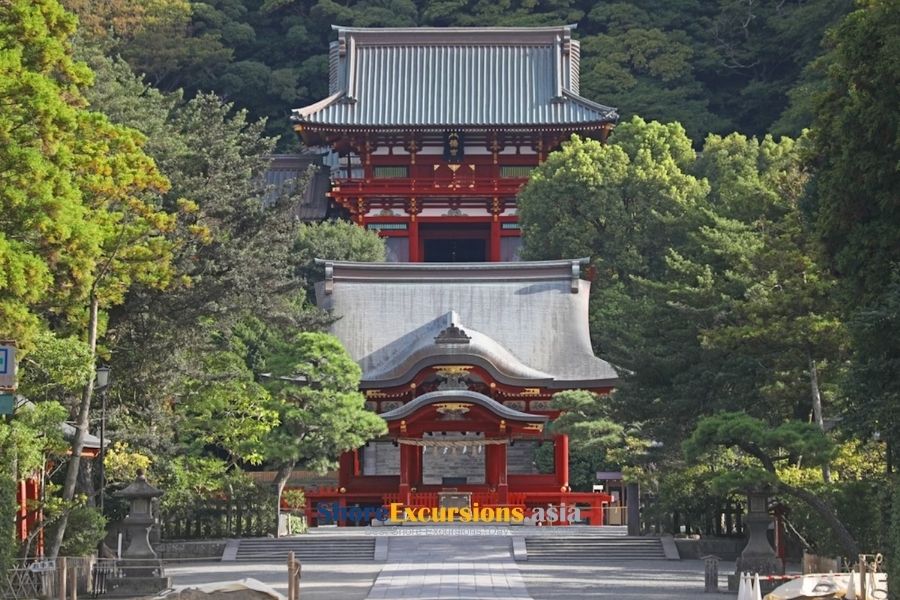
Dedicated to Hachiman, the god of warriors, the shrine’s importance extended beyond religion. For centuries, it served as a place of worship, political ritual, and public gatherings, cementing Kamakura’s status as a samurai capital. Today, visitors still feel echoes of that past as they climb the grand stairways and walk the same paths as warriors and nobles once did.
Architecture and Layout
The approach to Tsurugaoka Hachimangu is as striking as the shrine itself. Travelers begin at a massive red Torii gate that marks the entrance, and then follow the Dankazura, a wide, tree-lined avenue originally designed to resemble a dragon’s back. During cherry blossom season, this path transforms into a breathtaking tunnel of flowers, making it one of the most photographed spots in Kamakura.
The Approach (Torii Gate and Dankazura)
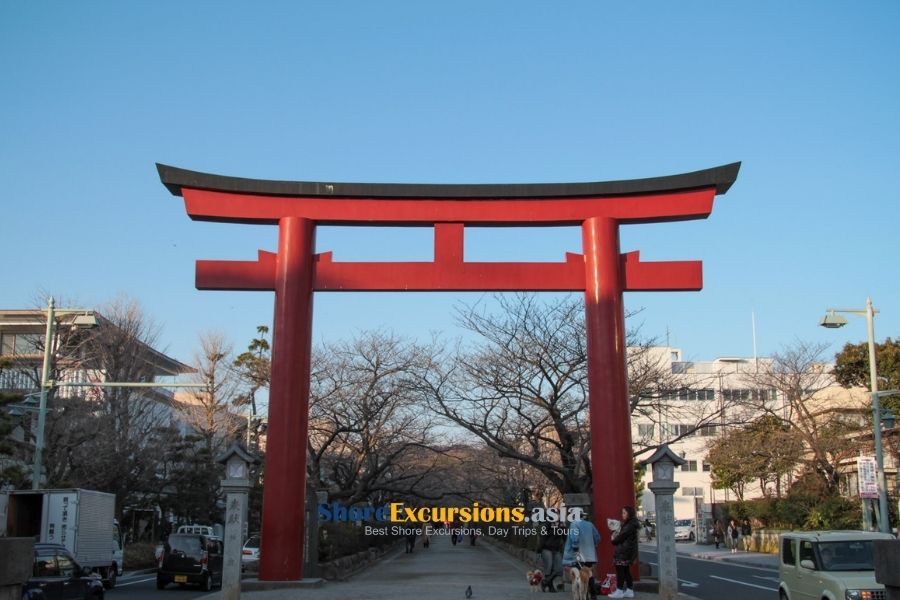
The journey to Tsurugaoka Hachimangu begins at a towering vermilion Torii gate, a symbolic threshold marking the transition from the secular world to the sacred. Beyond this gate stretches the Dankazura, a wide, tree-lined path constructed in the 12th century under the order of shogun Minamoto no Yoritomo. Designed to gradually rise in elevation, the path gives the illusion of a dragon’s back – a powerful creature believed to protect the shrine.
- In spring, the cherry blossoms that line both sides of the avenue bloom in full splendor, transforming it into a breathtaking tunnel of flowers. This makes it one of the most photographed spots in Kamakura.
- In autumn, the vibrant red and gold foliage creates a strikingly serene and contemplative atmosphere, inviting visitors to slow down and reflect.
The Main Shrine (Honden)
At the heart of the complex lies the Main Shrine (Honden), built in the traditional Shinto architectural style. With its vivid vermilion beams, white walls, and elaborate wooden carvings, the Honden radiates both elegance and spiritual gravitas. Perched at the top of a grand stone staircase, it commands a sweeping view of the grounds and even parts of the city beyond.
- Inside, Shinto rituals and ceremonies continue to this day, connecting visitors with centuries of cultural and spiritual tradition.
- The present structure was reconstructed in 1828, following earlier fires and natural disasters, yet it faithfully preserves the solemn grandeur of its historical predecessors.
Auxiliary Shrines and Structures
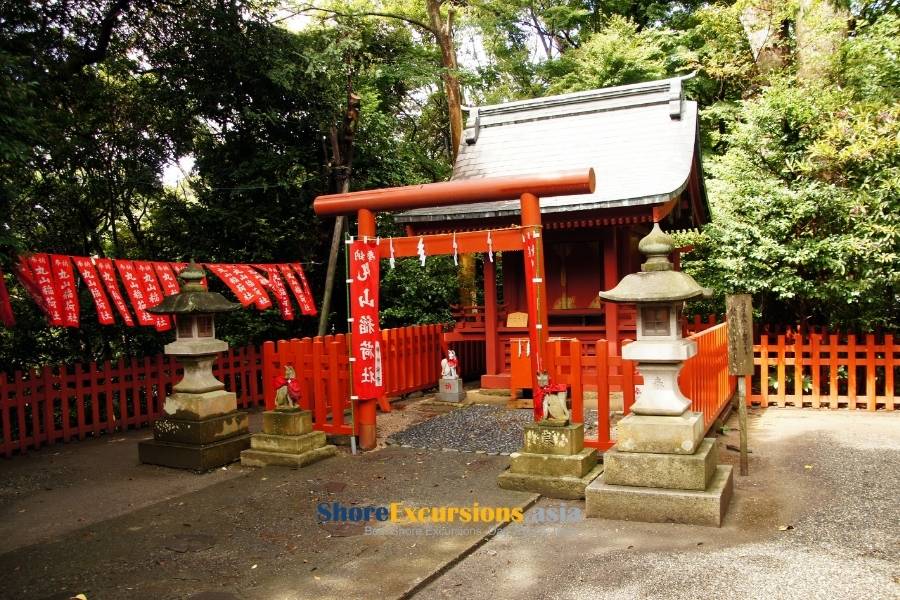
Scattered throughout the precincts are several smaller shrines dedicated to a variety of deities, showcasing the diversity of Japanese spiritual practices.
- Some shrines attract worshippers seeking blessings for marriage, academic success, or safe travels.
- The grounds also feature sacred bridges, ponds, and wooden corridors, creating spaces for quiet contemplation and reinforcing the shrine’s meditative atmosphere.
Genpei Pond and Gardens
A highlight of the shrine grounds is the Genpei Pond, which is symbolically divided into two sections representing the historic rivalry between the Minamoto (Genji) and Taira (Heike) clans. This feature not only embodies themes of conflict and resolution but also serves as a poignant reminder of life’s impermanence – a central concept in Japanese aesthetics.
- In summer, lotus blossoms spread across the pond, evoking the Buddhist idea of purity and transcendence rising from muddy waters.
- The surrounding gardens, arranged with careful attention to balance and harmony, reflect both feng shui principles and traditional Japanese design, offering visitors a serene space to pause and reflect.
Overall Layout
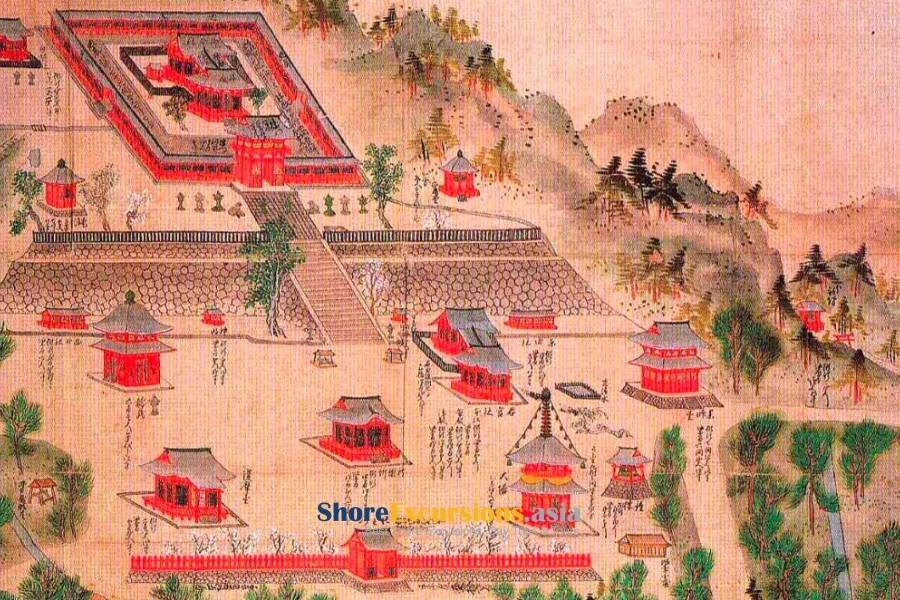
The shrine’s layout follows a north-south axis, deliberately designed to reflect both religious symbolism and political authority. This alignment underscores Tsurugaoka Hachimangu’s dual role as a spiritual sanctuary and a political center during the Kamakura shogunate. Its architecture is not just about worship but also about asserting the power and vision of Minamoto no Yoritomo, who established Kamakura as Japan’s first military capital.
Festivals & Cultural Events Related To Tsurugaoka Hachimangu Shrine
Tsurugaoka Hachimangu is not just a historical landmark but a living cultural stage, where the rhythms of Shinto rituals and traditional celebrations continue to shape the identity of Kamakura. Throughout the year, the shrine hosts a vibrant calendar of festivals that blend spirituality, community, and artistry, giving visitors a rare opportunity to witness Japanese culture in its most authentic form.
Reitaisai (Annual Grand Festival) - September
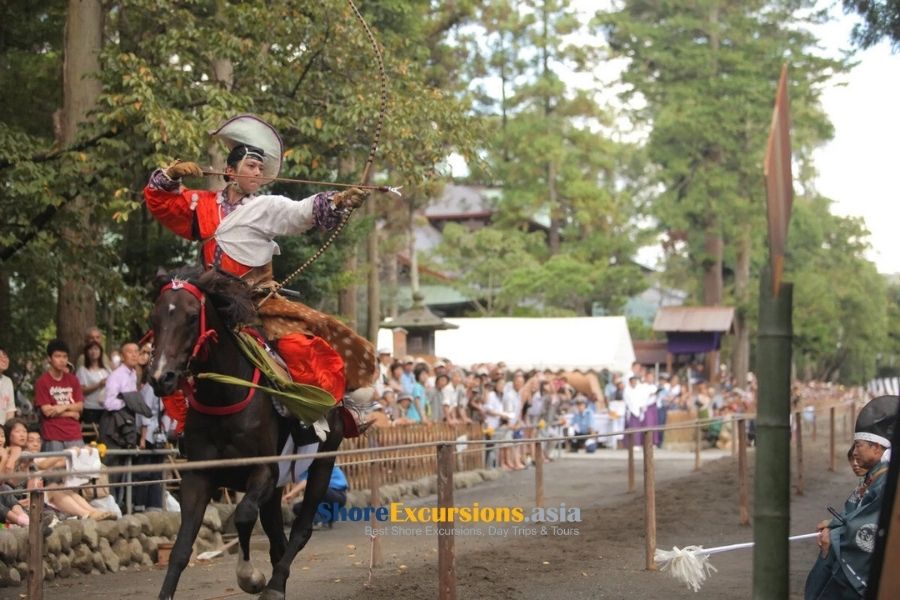
The Reitaisai, held every year from September 14 to 16, is the shrine’s most important festival. Rooted in centuries of tradition, it commemorates the deities enshrined at Tsurugaoka Hachimangu and celebrates the martial spirit of the Kamakura shogunate.
- The highlight of the festival is Yabusame (horseback archery), performed on the final day. Archers dressed in full samurai regalia gallop down a 250-meter track, loosing arrows at wooden targets with remarkable precision. This ritual is not just entertainment—it symbolizes the fusion of martial discipline and spiritual devotion that defined the samurai ethos.
- Processions of priests, shrine maidens (miko), and locals in traditional attire further immerse visitors in an atmosphere reminiscent of medieval Japan.
New Year’s Celebrations (Hatsumode) - January
At the turn of the year, Tsurugaoka Hachimangu becomes one of the busiest shrines in Kanagawa Prefecture. Over two million people visit during the first three days of January to perform Hatsumode, the traditional practice of offering prayers for health, prosperity, and protection in the year ahead.
- Temporary stalls line the approach, selling charms (omamori), fortunes (omikuji), and festive food.
- Visitors can also witness Shinto purification rituals and occasionally performances of gagaku (ancient court music).
Spring and Autumn Ceremonies
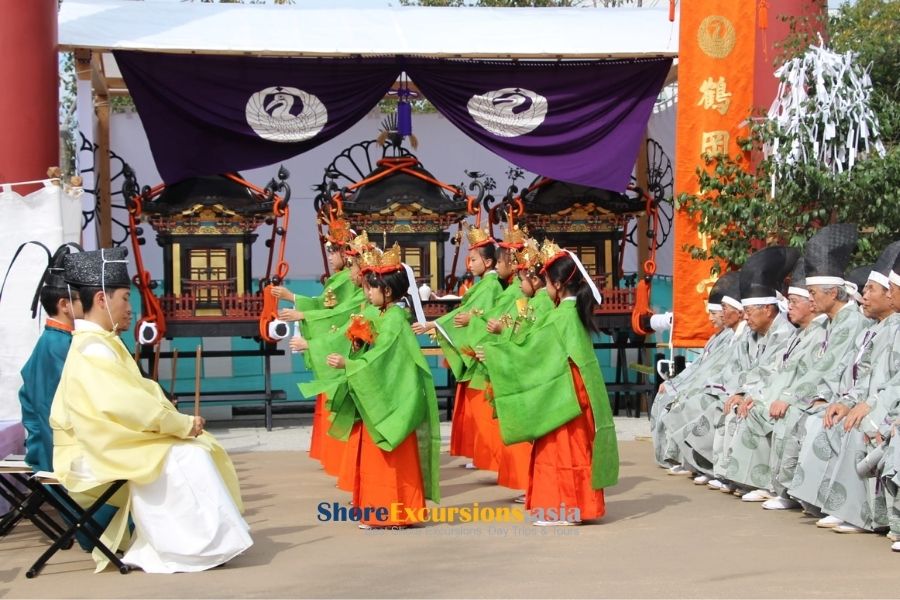
The beauty of Tsurugaoka Hachimangu is deeply tied to the rhythm of the seasons, and the shrine hosts ceremonies that celebrate nature’s changing cycle. These events are not only visually spectacular but also reinforce Shinto’s connection to the land, agriculture, and renewal of life.
- In spring (April), the shrine grounds are blanketed in cherry blossoms, attracting visitors for hanami (flower viewing). Rituals performed at this time express gratitude for nature’s rebirth and prayers for a prosperous planting season.
- In autumn (October - November), fiery hues of red and gold surround the shrine. Ceremonies during this period honor the harvest and acknowledge the spiritual significance of seasonal transition, preparing the community for the winter months ahead.
Other Annual Events at Tsurugaoka Hachimangu Shrine
Beyond its major festivals, Tsurugaoka Hachimangu maintains a vibrant cultural calendar filled with rituals both solemn and festive. These events weave together local tradition, spiritual practice, and joyful community gatherings.
- Setsubun (February 3 or 4): Marking the start of spring in the old lunar calendar, this lively bean-throwing festival drives away evil spirits and invites good fortune. Priests, miko (shrine maidens), and even local celebrities join in the ritual chant: “Oni wa soto, fuku wa uchi!” (“Demons out, luck in!”).
- Tanabata (July 7): The shrine is decorated with colorful strips of paper, each carrying handwritten wishes. This festival celebrates the celestial love story of Orihime and Hikoboshi, who meet once a year across the Milky Way.
- Community and seasonal rites: Smaller rituals held throughout the year such as blessings for children’s growth, ceremonies for safe journeys, or prayers for a good harvest. These help maintain the shrine’s role as a spiritual anchor and cultural hub for Kamakura residents.
Immersive Visitor Experiences at Tsurugaoka Hachimangu
A visit to Tsurugaoka Hachimangu is far more than sightseeing, it is a journey into Japan’s cultural heart, where history, spirituality, and natural beauty converge. From strolling under cherry blossoms to witnessing sacred rituals, the shrine offers travelers a variety of experiences that appeal to both the senses and the soul.
Walking the Dankazura: A Path Through History
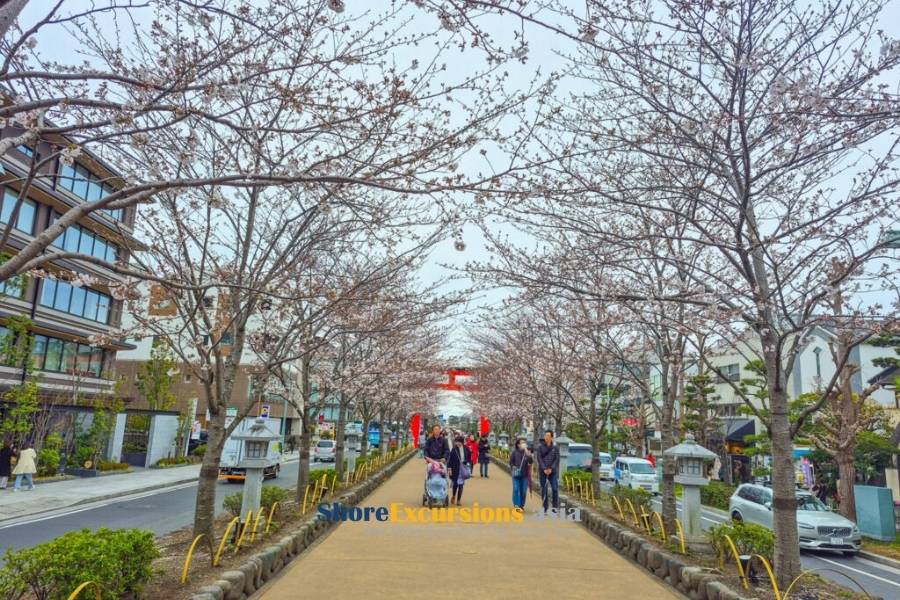
The Dankazura, a broad, tree-lined avenue leading directly to the shrine, is more than a walkway, it is a symbolic reminder of Kamakura’s urban planning under the shogunate. The path narrows slightly as it approaches the shrine, creating a perspective effect that makes the approach feel longer and more grand.
- In spring, the blooming cherry trees transform the avenue into a pink tunnel, with petals carpeting the ground - a favorite among photographers and romantics alike.
- In autumn, golden ginkgo leaves create a completely different but equally mesmerizing landscape. Walking here is not just a physical journey but also a symbolic act of leaving behind the ordinary world and entering the sacred domain.
Exploring the Shrine Museum: A Samurai Legacy
For those fascinated by Japan’s warrior past, the Tsurugaoka Hachimangu Museum is a hidden gem. It houses an impressive collection of artifacts, including:
- Samurai armor and swords, some of which belonged to the Minamoto clan, founders of the Kamakura shogunate.
- Ancient manuscripts and documents, which shed light on the administrative and spiritual role the shrine played in medieval Japan.
- Ceremonial objects, such as masks, musical instruments, and ritual tools, offering insight into the continuity of Shinto practices. The museum provides essential historical context, helping visitors understand how the shrine functioned not only as a religious site but also as a political and cultural hub.
Spiritual Reflection: Finding Peace Amid Tradition
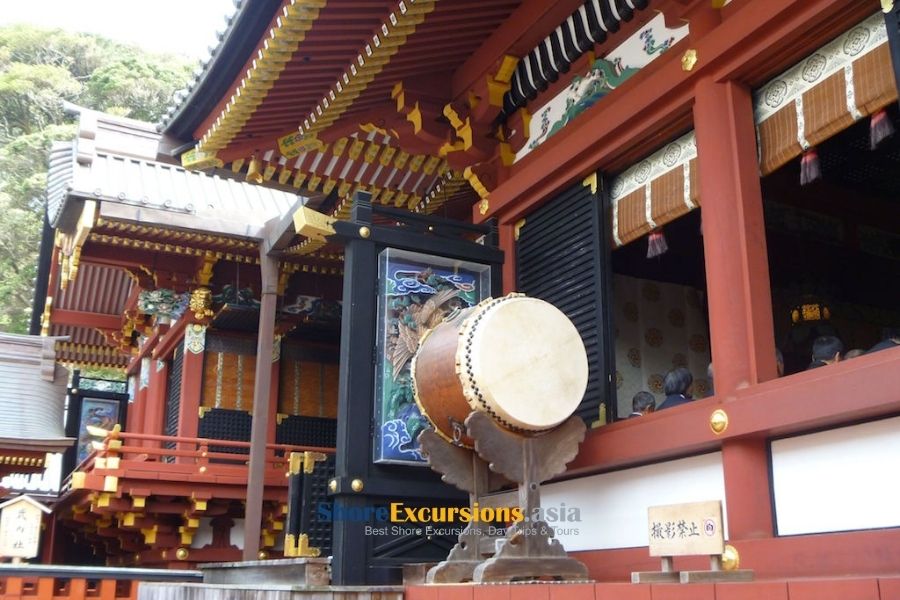
Beyond its historical treasures, Tsurugaoka Hachimangu remains a deeply spiritual place. Visitors can engage with Japanese customs in simple but meaningful ways:
- Offering prayers at the main hall, often accompanied by the ritual clapping and bowing of Shinto tradition.
- Drawing a fortune slip (omikuji), which may reveal blessings or warnings, followed by tying the slip to a designated rack to seek divine guidance.
- Resting by the gardens and ponds, where the gentle movement of lotus blossoms and koi fish create an atmosphere of quiet meditation. Many travelers, regardless of faith, describe leaving the shrine with a sense of calm and renewal.
Capturing Beauty & Cultural Immersion
Every corner of the shrine is strikingly photogenic, from the grand stairways leading up to the main hall to the vibrant vermilion beams of the structures framed against a blue sky. Yet, the true depth of the experience lies not only in photography but in immersion:
- Observing local worshippers, from families praying for their children’s future to couples seeking blessings for marriage, reveals the shrine’s continuing role in daily Japanese life.
- Participating in or quietly witnessing seasonal rituals allows travelers to connect with traditions that have endured for centuries.
How to Visit Tsurugaoka Hachimangu Shrine?
Location and Access
Tsurugaoka Hachimangu sits at the very heart of Kamakura, making it one of the city’s most accessible and iconic landmarks. From Kamakura Station (served by the JR Yokosuka Line and the Enoden Line), it is just a 10-minute walk through the historic streets, culminating in the dramatic approach along the Dankazura.
For international travelers arriving by cruise ship, the shrine is a popular stop on shore excursions from Yokohama Port. The journey from Yokohama to Kamakura takes about one hour by train or slightly longer by coach. Many organized tours from both Yokohama and Tokyo include Tsurugaoka Hachimangu as part of a Kamakura day trip, often combined with visits to the Great Buddha of Kōtoku-in and Hase-dera Temple. This makes visiting the shrine both convenient and efficient without the stress of navigating unfamiliar transport routes.
Best Time to Visit the Shrine
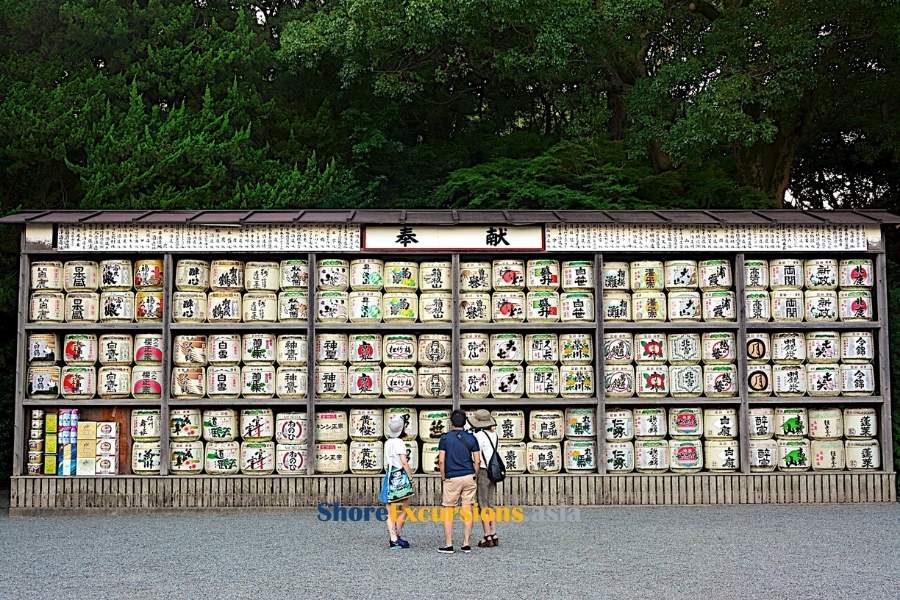
While the shrine is open year-round, each season offers a unique atmosphere and reason to visit:
- Spring (March - April): The Dankazura transforms into a tunnel of cherry blossoms, one of the most enchanting sights in Kamakura. This is peak season for both photography and hanami (flower viewing).
- Summer (July - August): The lotus blossoms in Genpei Pond bloom vibrantly, symbolizing purity and resilience. The lush greenery of the shrine grounds provides a refreshing escape from the summer heat.
- Autumn (October - November): The shrine is bathed in brilliant shades of red and gold foliage, especially around the main staircase and gardens. Seasonal rituals add cultural depth to the visit.
- Winter (January): The New Year period is one of the shrine’s busiest times, drawing millions for Hatsumode, the year’s first prayer. After the holiday rush, the grounds become quieter, ideal for travelers seeking a reflective, less-crowded experience.
Practical Tips for Travelers
To make the most of your visit, keep in mind a few essential guidelines:
- Dress comfortably: Visiting involves walking long paths and climbing stone staircases. Comfortable shoes are recommended.
- Respect traditions: While photography is allowed in most outdoor spaces, it may be restricted inside certain shrine buildings or during rituals. Always follow posted signs and observe how locals behave.
- Consider a guided tour: English-speaking guides or group tours provide valuable context, sharing historical background, legends of the Minamoto clan, and explanations of Shinto rituals.
- Arrive early or late in the day: Midday can be crowded, especially during weekends and festival periods. Visiting in the morning or late afternoon allows for a more serene experience.
- Combine with nearby attractions: The Great Buddha, Hase-dera Temple, and Komachi-dori shopping street are all within easy reach, making a full-day Kamakura itinerary both diverse and rewarding.
Nearby Attractions: Exploring Kamakura Beyond Tsurugaoka Hachimangu
A visit to Tsurugaoka Hachimangu is often just the beginning of a Kamakura adventure. The city, once the seat of Japan’s first shogunate, is a treasure trove of spiritual landmarks, historic temples, and lively streets. Travelers can easily combine the shrine with nearby attractions for a day filled with culture, history, and local flavor.
Kōtoku-in Temple - The Great Buddha of Kamakura
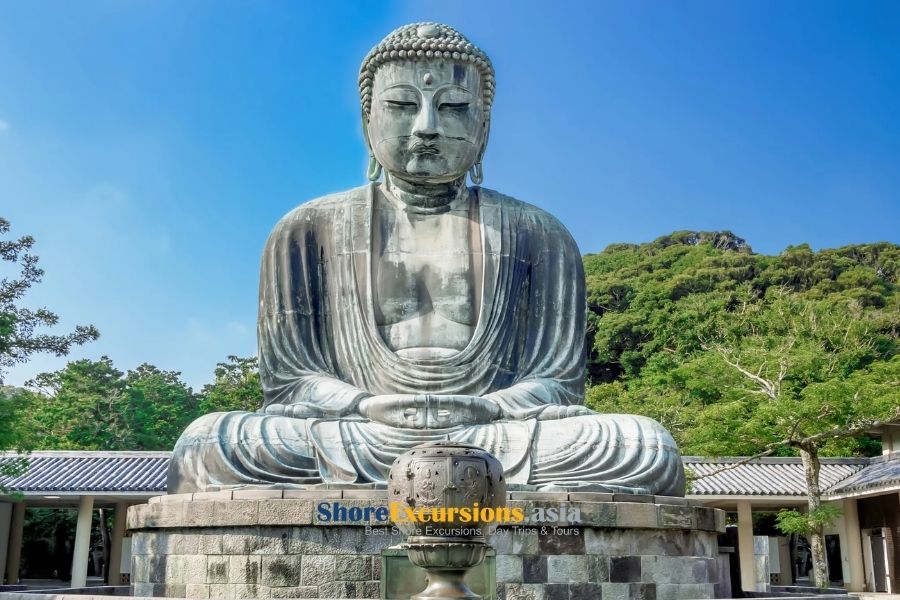
Just a short bus or train ride from Tsurugaoka Hachimangu lies Kōtoku-in Temple, home to the famous Daibutsu (Great Buddha). This monumental bronze statue, standing over 11 meters tall, dates back to the 13th century and has become one of Japan’s most iconic images.
- The Great Buddha was originally housed inside a large wooden hall, which was destroyed multiple times by typhoons and tsunamis. Today, the statue sits majestically in the open air, creating a serene and powerful atmosphere.
- For a small fee, visitors can even step inside the hollow statue, offering a rare perspective on its construction.
- Surrounded by trees and open skies, this site is both awe-inspiring and deeply tranquil, making it a must-see for first-time visitors to Kamakura.
Hasedera Temple - Temple of the Eleven-Headed Kannon
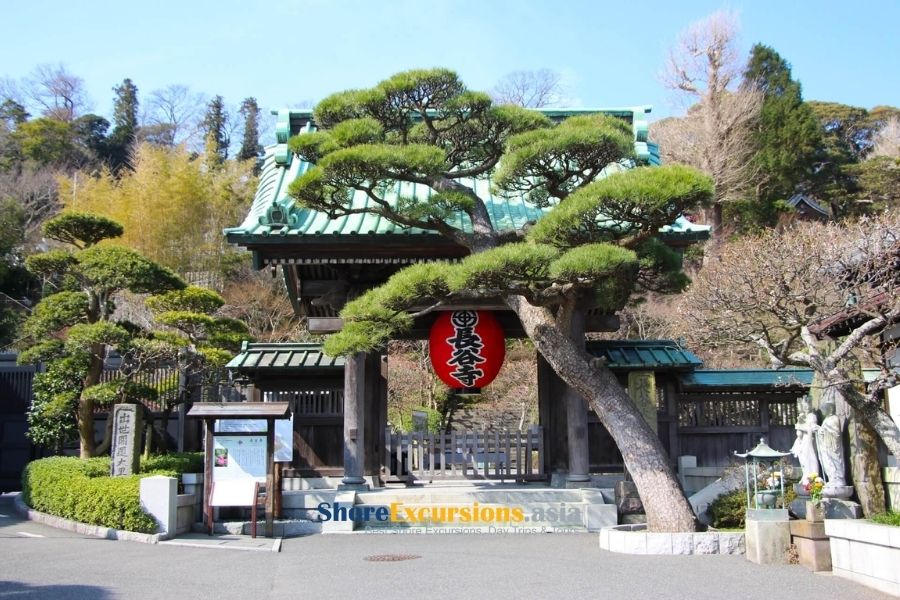
Not far from the Great Buddha is Hasedera Temple, renowned for its breathtaking wooden statue of Kannon, the Goddess of Mercy. Carved in the 8th century, the statue stands nearly 10 meters tall and is one of the largest of its kind in Japan.
- The temple grounds feature beautifully landscaped gardens, koi ponds, and walking paths that change character with the seasons - cherry blossoms in spring, hydrangeas in early summer, and colorful leaves in autumn.
- Another highlight is the Jizō-do Hall, where hundreds of small stone Jizō statues are placed by families praying for the health and protection of children.
- From the temple’s hillside terrace, visitors can enjoy sweeping views of Kamakura’s coastline and Sagami Bay, especially stunning at sunset.
Komachi-dori Street - Flavors & Souvenirs of Kamakura
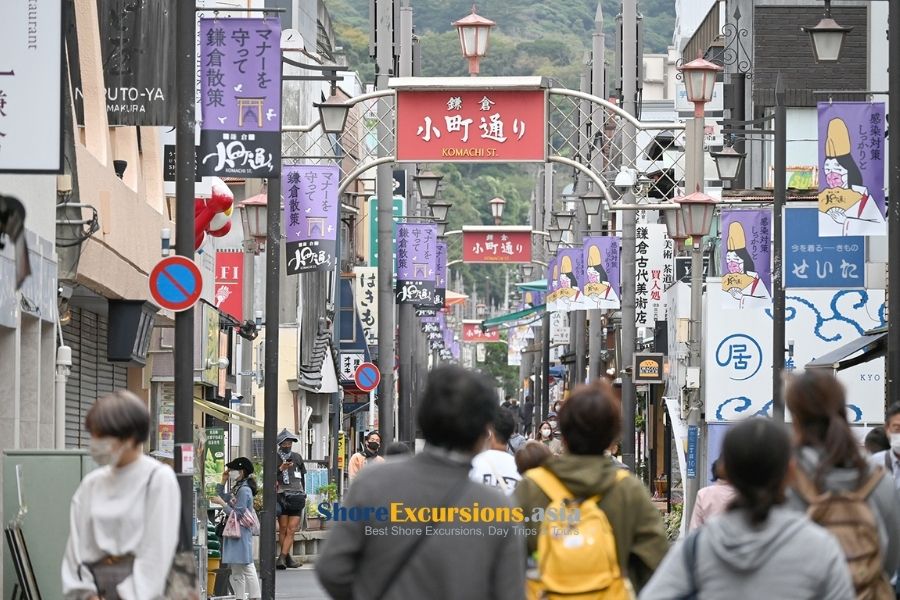
Back near Kamakura Station, Komachi-dori Street offers a lively counterpoint to the city’s spiritual side. This bustling pedestrian street is lined with shops, cafes, and food stalls, making it the perfect spot to sample local specialties and pick up souvenirs.
- Popular treats include matcha ice cream, freshly baked rice crackers, purple sweet potato (imo) desserts, and shirasu (whitebait) snacks.
- Shops also sell handcrafted goods, traditional ceramics, and seasonal trinkets, ideal for gifts or keepsakes.
- The street comes alive on weekends, buzzing with both locals and tourists, creating a festive, energetic atmosphere that contrasts beautifully with the tranquility of the temples.
Crafting a Well-Rounded Kamakura Experience
For travelers with limited time, joining a Kamakura Shore Excursion or guided tour is a great way to experience the city’s highlights without logistical stress. This blend of spirituality, history, and cuisine ensures a memorable journey into the essence of Kamakura, whether you’re on a short day trip or an extended exploration. Many itineraries combine:
- Religious sites such as Tsurugaoka Hachimangu, Kōtoku-in, and Hasedera.
- Cultural walks through historical neighborhoods and temple-lined streets.
- Culinary stops on Komachi-dori, where travelers can taste authentic local flavors.
Why Tsurugaoka Hachimangu Shrine Matters?
The significance of Tsurugaoka Hachimangu goes beyond its physical beauty. It is a living monument to Japan’s warrior past, a guardian of Shinto traditions, and a cultural hub for festivals that still captivate locals and travelers alike. Visiting the shrine means stepping into a narrative that spans centuries – from the rise of the Minamoto clan to the prayers of today’s visitors seeking peace and blessings.
For travelers seeking more than surface-level sightseeing, this shrine offers the chance to connect with the essence of Japanese spirituality and aesthetics. Its combination of grandeur and tranquility makes it a perfect stop on any journey through Kamakura.
Tsurugaoka Hachimangu Shrine is not only Kamakura’s most famous landmark but also a gateway into Japan’s cultural soul. With its deep historical roots, stunning architecture, vibrant festivals, and serene atmosphere, it provides one of the most rewarding cultural experiences for visitors to Japan. Whether as part of a Tokyo Shore Excursion, a Yokohama Shore Excursion, or a dedicated Kamakura day trip, exploring this shrine ensures memories that linger long after your voyage ends.
Contact Japan Shore Excursions today and plan your ideal shore trip!

